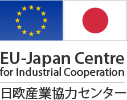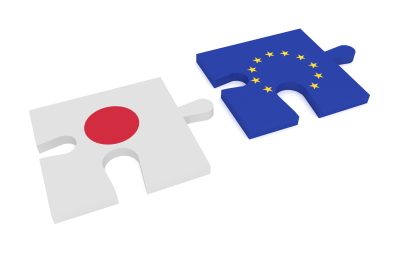On February 1st, 2019, the EU and Japan Economic Partnership Agreement (EPA) came into force. The EPA signifies a new chapter in the economic and political cooperation between two of the largest economies in the world. While much of the attention is directed at lowering trade barriers such as tariffs for agricultural products or automobiles, the Agreement also includes a mutual commitment to open each other’s government procurement markets further, beyond the scope of the WTO Agreement on Public Procurement (GPA).
The information here is an overview of these commitments, as far as entry to the Japanese market is concerned. For details on the EU commitments, please consult the EU-Japan EPA-pages on the European Commission’s website.
Main points
- Enlarged public procurement market access to additional government entities;
- Removal of Operational Safety Clause for railway related procurement
- Opening up of procurement for (renewable) power infrastructure in Japanese regions
- Additional service-categories
- Commitment to ease qualification as supplier
- More clarity with regards to technical specifications, test reports and environmental conditions
- Guarantees for impartiality of domestic review and challenging procedures
- Establishment of a Committee on Government Procurement.
- JTTP Helpdesk and the impact of the EU-Japan EPA on Government procurement
Enlarged public procurement market access
On top of market access regulated by the WTO GPA, the EPA will give European companies access to additional government entities in Japan. These are:
National government agencies
At the central level, in addition to entities listed in Group B of Annex 3 to Japan's Appendix 1 to the GPA, the following six entities are covered by the EPA:
- Information Technology Promotion Agency
- Pharmaceutical and Medical devices Agency
- Japan Community Healthcare Organization
- Agriculture, Forestry and Fisheries Credit Foundation
- National Agency for Automotive Safety and Victims’ Aid
- Organization for Environment Improvement around International Airport
Sub-central level entities
At the sub-central level, which comprises of Japan’s 47 prefectures, and designated cities, the Agreement offers increased access for EU suppliers.
Designated City
The Japanese government has agreed to include an additional designated city, i.e. cities with a population larger than 500,000 inhabitants.
Kumamoto City was already included in Japan’s Trans Pacific Partnership (TPP) Agreement in 2016, but is formally not included in the WTO GPA. The city does however public large contracts under WTO regulations.
Local independent administrative agencies
The following agencies, mostly falling under the jurisdiction of prefectures and designated cities will have to provide equal access to procurement offers to EU suppliers under the EPA. The list is called indicative as more entities might be added in the future.
- Aichi Public University Corporation
- Akita International University
- Akita Prefectural Center of Development and Disability
- Akita Prefectural Hospital Organization
- Akita Prefectural University
- Aomori Prefectural Industrial Technology Research Center
- Aomori University of Health and Welfare
- Ehime Prefectural University of Health Sciences
- Fukui Prefectural University
- Fukuoka City Hospital Organization
- Fukuoka Prefectural University
- Fukuoka Women’s University
- Fukushima Medical University
- Gifu College of Nursing
- Gifu Prefectural General Medical Center
- Gifu Prefectural Gero Hot Spring Hospital
- Gifu Prefectural Tajimi Hospital
- Hiroshima City Hospital Organization
- Hiroshima City University
- Hokkaido Research Organization
- Ishikawa Prefectural Public University Corporation
- Iwate Industrial Research Institute
- Iwate Prefectural University
- Kanagawa Prefectural Hospital Organization
- Kanagawa Institute of Industrial Science and Technology
- Kobe City Hospital Organization
- Kobe City University of Foreign Studies
- Kochi Prefectural Public University Corporation
- Kyoto City Hospital Organization
- Kyoto City University of Arts
- Kyoto Municipal Institute of Industrial Technology and Culture
- Kyoto Prefectural Public University Corporation
- Kyushu Dental University
- Mie Prefectural College of Nursing
- Mie Prefectural General Medical Center
- Miyagi Children’s Hospital
- Miyagi Prefectural Hospital Organization
- Miyagi University
- Miyazaki Prefectural Nursing University
- Nagano Prefectural Hospital Organization
- Nagasaki Prefectural Public University Corporation
- Nagoya City University
- Nara Medical University
- Nara Prefectural Hospital Organization
- Nara Prefectural University
- Niigata College of Nursing
- Oita Prefectural College of Arts and Culture
- Oita University of Nursing and Health Sciences
- Okayama City General Medical Center
- Okayama Prefectural University
- Okayama Psychiatric Medical Center
- Osaka City Hospital Organization
- Osaka City University
- Osaka Prefectural Hospital Organization
- Osaka Prefecture University
- Prefectural University of Hiroshima
- Prefectural University of Kumamoto
- Research Institute of Environment, Agriculture and Fisheries, Osaka Prefecture
- Saga-Ken Medical Centre Koseikan
- Saitama Prefectural University
- Sakai City Hospital
- Sapporo City University
- Sapporo Medical University
- Shizuoka Prefectural Hospital Organization
- Shizuoka Prefectural University Corporation
- Shizuoka University of Arts and Culture
- Technology Research Institute of Osaka Prefecture
- Technology Research Institute of Osaka Prefecture
- The University of Aizu
- The University of Kitakyushu
- The University of Shiga Prefecture
- The University of Shimane
- Tochigi Cancer Center
- Tokushima Prefecture Naruto Hospital
- Tokyo Metropolitan Geriatric Hospital and Institute of Gerontology
- Tokyo Metropolitan Industrial Technology Research Institute
- Tokyo Metropolitan University
- Tottori Institute of Industrial Technology
- Toyama Prefectural University
- University of Hyogo
- University of Niigata Prefecture
- Wakayama Medical University
- Yamagata Prefectural Public University Corporation
- Yamagata Prefectural University of Health Sciences
- Yamaguchi Prefectural Hospital Organization
- Yamaguchi Prefectural Industrial Technology Institute
- Yamaguchi Prefectural University
- Yamanashi Prefectural Hospital Organization
Core cities
The addition of (currently) 54 so-called “core cities” (Chūkakushi), which are cities with a population between approximately 300,000 and 500,000 inhabitants, signifies a substantial enlargement of the public procurement market in Japan, in that it potentially opens up a new category of government entities to international suppliers. It should be noted however that construction tenders are not covered by the agreement. The scope of the FTA includes the supply of goods and services, in addition to architectural design and consulting. Thresholds for procurement will be a the same level as those for prefectures and designated cities.
Removal of Operational Safety Clause for railway related procurement
The Operational Safety Clause (OSC) in the WTO GPA had been a contentious issue between Japan and the EU for a long time, as the liberal application of the Clause by the Japanese government effectively barred foreign suppliers from the Japanese railway market.
In the EPA, the clause is removed for procurement of goods and services from contracts above 400,000 SDR (¥72,000,000(As of April 1, 2024)) (approx. €483.000) and procurement by the following entities will be open to suppliers from the EU.
- JR Hokkaido
- JR Freight
- Japan Railway Construction Transport and Technology Agency (JRTT)
- JR Shikoku
- Tokyo Metro Co. Ltd.
Publicly-owned power generation
Although the majority of electric power infrastructure is privatized, their are still 26 prefectures and 3 cities (Yokohama, Kitakyushu and Kumamoto) where part of the production, transport and distribution infrastructure of electricity is managed by public utilities. This concerns primarily infrastructure such as dams, wind parks and solar parks. In the WTO GPA, Japan excludes procurement related to the production, transport or distribution of electricity by sub-central government entities (See Annex 2, Note 5). The EPA however opens procurement related to these for European companies, with thresholds applicable to sub-central government entities. As of February 2018, it concerns the following entities (Links are to departments in charge (in Japanese only):
| Iwate-ken | |
| Yamagata-ken | |
| Gunma-ken | |
| Kanagawa-ken | |
| Toyama-ken | |
| Nagano-ken | |
| Kyoto-fu | |
|
Hyogo-ken |
Tottori-ken |
| Okayama-ken | |
| Tokushima-ken | |
| Kochi-ken | |
| Kumamoto-ken | |
| Miyazaki-ken | |
| Kitakyushu-shi | |
|
Kumamoto-shi |
Services
Both parties have also agreed to open up additional service categories for EU suppliers, on top of those specified in Annex 5 of the WTO GPA. At the national level government level these are the following (Codes denote UN Provisional Central Product Classification (CPC) 1991 codes)
- 754 Telecommunications related services
- 812 Insurance (including reinsurance) and pension fund services, except compulsory social security services
- 87201 Executive search services
- 87202 Placement services of office support personnel and other workers
- 87204 Supply services of domestic help personnel
- 87205 Supply services of other commercial or industrial workers
- 87206 Supply services of nursing personnel
- 87209 Supply services of other personnel
- 87501 Portrait photography services
- 87502 Advertising and related photography services
- 87503 Action photography services
- 87505 Photography processing services
- 87506 Motion picture processing services not related to the motion picture and television industries
- 87507 Restoration, copying and retouching services of photography
- 87509 Other photographic services
- 87901 Credit reporting services
- 87902 Collection agency services
- 87903 Telephone answering services
- 87905 Translation and interpretation services
- 87906 Mailing list compilation and mailing services
- 87907 Specialty design services;
At the sub-central government level (Prefectures and designated cities)
- 643 Beverage serving services
- 83106 to 83108 Leasing or rental services concerning agricultural machinery and equipment without operator
- 83203 Leasing or rental services concerning furniture and other household Appliances
- 83204 Leasing or rental services concerning pleasure and leisure equipment
- 83209 Leasing or rental services concerning other personal or household goods
- 86501 General management consulting services
- 86502 Financial management consulting services (except business tax)
- 86503 Marketing management consulting services
- 86504 Human resources management consulting services
- 86505 Production management consulting services
- 86509 Other management consulting services
Commitment to ease qualification as supplier
One of the features of Japanese public procurement is that suppliers need to qualify in advance in order to be allowed to participate in competitive tender procedures. The lack of transparency and perceived ambiguity favoring local suppliers with regard to the conditions to qualify as a supplier have long been a source of frustration for foreign companies, barring them from entering the procurement market.
This applies in particular to qualifying for participation in construction work-related tenders in Japan, where a Business Evaluation or Keishin for short, is required. In the EPA, Japan has committed itself to that authorities will ensure that the assessment will take place in a non-discriminatory manner and will recognize accomplishments make in the company’s home country as equivalent. This includes information such as:
- Number of technical staff
- Labour welfare condition (social insurance)
- Number of years in construction business
- Accounting practices in construction business
- R&D expenditures
- ISO certification
- Employment and training of young engineers and trained workers
- Amount of sales for completed construction work
- Amount of sales for completed construction work as prime contractor
And also financial information such as
- Equity capital
- EBITDA
- Net interest expense to sales ratio
- Liabilities turnover period
- Gross profit/gross capital ratio
- Recurring profit/sales amount ratio
- Equity capital/fixed asset ratio
- Equity ratio
- Cash flow from operating activities and
- Amount of accumulated earnings
Technical specifications & Test reports
Country-specific technical specifications and test reports are often used to bar foreign suppliers from tenders. In the EPA, in order to increase mutual recognition of technical standards and test reports specified in tenders, both parties will ensure that the specifications are appropriate to the characteristics of the supplies or services required, objectively verifiable and non-discriminatory and accessible to all parties interested. With regard to test-reports the procuring entities shall accept the results of conformity assessment procedures conducted by registered assessment bodies in the EU and Japan.
Domestic review procedures and challenging systems
While Japan already has a review and challenging system in place under the WTO GPA, there have been long-standing questions about the impartiality and independence of reviewing authorities in Japan, as members were often selected from the same organization they were to review. The EPA includes further assurances to ensure that suppliers challenge results and have the procedures reviewed. These include:
- Independence and impartiality of reviewing boards members;
- Members should possess appropriate professional/legal qualifications;
- Adoption of rapid interim measures to ensure that the supplier demanding the review will still be able to participate;
- Postponement of the tender decision in case of a challenge until a decision of the review authority has been taken;
Committee on Government Procurement
The Agreement also arranges the establishment of a Committee on Government Procurement. The Committee is
- to make recommendations in case the provisions of the GPA are amended or superseded by another agreement or when compensator adjustment are need in case of modifications in terms of coverage for instance in case of entities being merged or reorganized etc.
- ensure exchange of statistical information etc. but also procurement opportunities
- consider issues regarding government procurement
This Committee shall be composed of officials from the Government of Japan and the European Commission.
Impact of EPA on Government Procurement practices in Japan
With the EPA signed, the next step is to make the Agreement work for both sides. The question in the coming years will be whether the commitments made by both sides will lead to new concrete opportunities for European companies in the Japanese government procurement market. For this, JTPP Helpdesk is also closely following developments in Japan and strives to act as a monitor/reporter of barriers for EU companies still found in the government procurement practice in Japan.
As part of these activities, JTPP Helpdesk conducted a survey among 900 officials and offices in charge of procurement and contracting at Japanese government organizations, regarding the impact of the EU-Japan EPA on procurement practices in Japan. The Report of this survey is available here (PDF).










